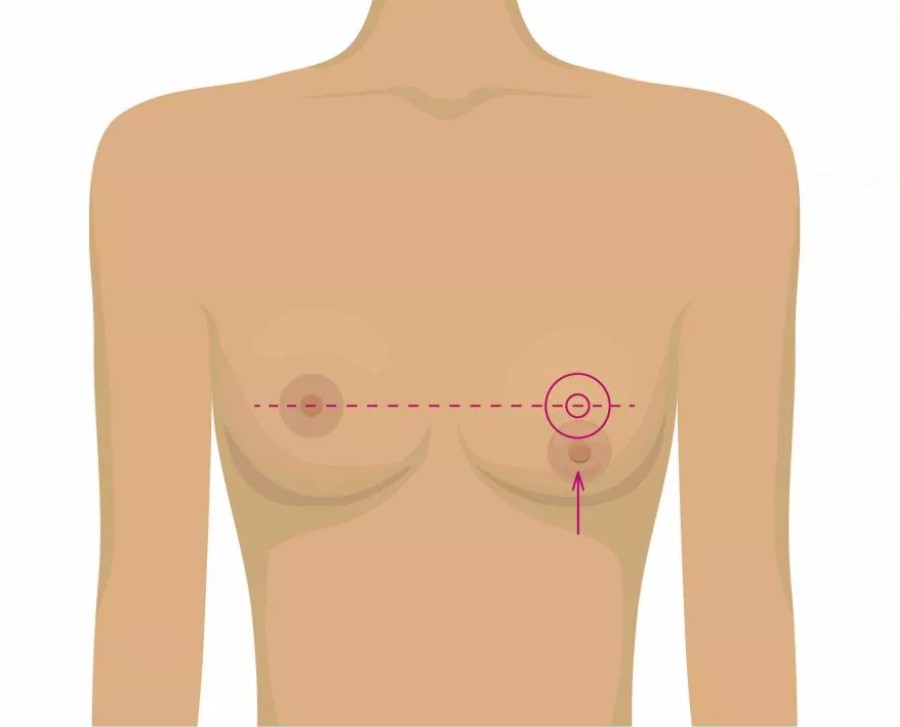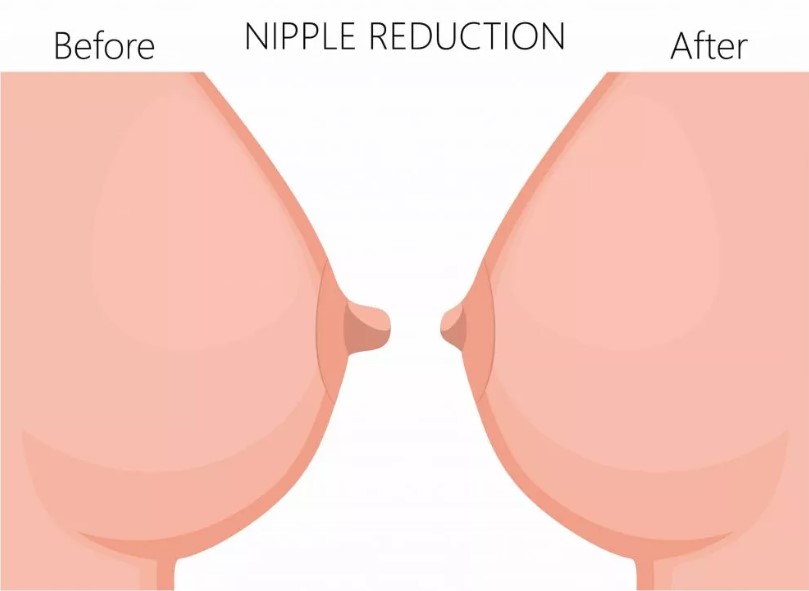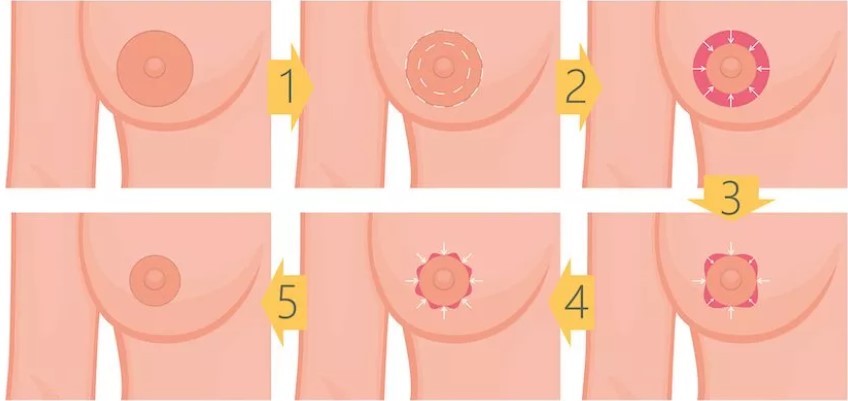Inverted nipples happen when the nipple goes inward instead of outward. This can make people feel embarrassed or uncomfortable. Luckily, there are surgeries that can help the nipple to look more normal.
Surgical solutions typically include liposuction, breast reduction, breast lift and nipple reduction. How serious the nipple inversion is will determine which surgery you get. The levels of nipple inversion range from mild to severe.
What are Inverted Nipples?
Inverted nipples are categorized into three grades:
Mild – Grade 1:
- The nipple might stick out a little bit with stimulation.
- May still be able to breastfeed without significant difficulty, in some cases, it might require some effort.
Moderate – Grade 2:
- The nipple has a noticeable inversion and does not stick out very far.
- Breastfeeding can be challenging and sometimes extra help is needed.
Severe – Grade 3:
- The nipple has a deep inversion and rarely sticks out.
- Constricted milk ducts can make it difficult to breastfeed.
Causes of Inverted Nipples
Genetics
Inverted nipples can be genetic, certain genes can make it more likely for a person to have inverted nipples. These genes affect the breast tissue, including the milk ducts and connective tissues that surround them. Certain genes can influence the length and tightness of milk ducts, which increases the chances of inverted nipples.
Underlying Tissue
Inverted nipples result from an imbalance in the muscles and tissues surrounding the nipple. This occurs when the milk ducts are excessively short or when there is an abundance of surrounding tissue, causing them to retract inwards and preventing the nipples from projecting outward.
Pregnancy and Breastfeeding
During pregnancy or breastfeeding, hormones can cause the nipples to retract inwards. However, once breastfeeding ends the hormones typically subside, and the nipples generally return to their original position.
Surgical Solutions for Inverted Nipples
Liposuction for Nipple Correction
Liposuction for breast reconstruction offers a minimally invasive solution to correct nipple inversion. Evidently, it may not be suitable for severe cases of inversion, but it can effectively address milder forms.
The surgeon makes tiny incisions near the base of the inverted nipple or areola. The surgeon uses a cannula is used to suction out excess fat contributing to the nipple inversion. This process helps to release the constriction and allows flat nipples to protrude.
Liposuction offers several benefits when used to correct nipple inversion:
- Minimally invasive
- Quick recovery
- Localised treatment
- Effective for mild cases
It’s essential to consult with a qualified plastic surgeon to determine if liposuction is the appropriate treatment for your specific case of nipple inversion.
Please note that Dr Doyle does not perform liposuction as a solo procedure. Liposuction is always combined with another surgical procedure.
Breast Reduction and Inverted Nipples
Breast reduction surgery, also referred to as reduction mammoplasty, is a surgical solution for addressing nipple inversion, particularly in cases linked to larger breast size and excess breast tissue. Here’s how breast reduction surgery can also act as a nipple surgery:
- Tissue Reduction: Reduction in breast size can reduce the pressure and tension that may be causing the nipples to invert. With less weight and volume pulling on the nipples, they are more likely to return to a naturally outward position.
- Repositioning: As part of the breast reduction procedure, Dr Doyle also repositions the nipple-areola complex. This can help ensure that the nipples remain everted after the surgery.
- Improved Support: Breast reduction surgery often includes reshaping and giving better support to the remaining breast tissue. This improved support can help the nipple correction.
In addition to helping with nipple inversion, breast reduction surgery offers several other benefits:
- Improved Aesthetics: More balanced and proportionate breasts often have a more lifted appearance.
- Relief from Pain: Significant relief from discomfort and pain, including back, neck, and shoulder pain, as well as skin irritation.
- Clothing Fit: Patients often find that clothing fits better, and they have more clothing options to choose from.
Breast Lift as a Solution to Saggy Nipples

A breast lift procedure, also known as periareolar mastopexy, can effectively lift saggy nipples and saggy nipples after breastfeeding.
Here’s how a breast lift can help address nipple inversion:
- Nipple Repositioning: Your plastic surgeon repositions the nipple-areola complex to a higher and more natural location on the breast mound, sometimes called a nipple lift.
- Reshaping and Tightening: Reshaping and tightening the breast tissue can provide better support to the nipples, preventing them from going inward and maintaining an outward position.
- Removal of Excess Skin: Through the removal of excess skin, breast reshaping and tightening occurs, which can play a role in alleviating nipple inversion in certain cases.
In addition to addressing nipple inversion, a breast lift offers several other advantages such as improved appearance and contour.
Breast Augmentation and Nipple Correction

Nipple correction can be added to a breast augmentation surgery. Moreover, when combined, these procedures offer a comprehensive approach to achieving aesthetic goals, restoring a flat nipple, and creating symmetrical, fuller breasts. Nipple correction can include areola reduction, nipple reduction, nipple removal or nipple reconstruction.
Combining breast augmentation with inverted nipple surgery offers patients a more comprehensive nipple enhancement, encompassing improved breast symmetry and enhanced nipples. Additionally, this inverted nipples surgery combination reduces the recovery period, minimising downtime for the patient.
Areola Reduction Procedure

Areola correction, or areola reduction surgery, is a procedure that decreases the diameter of one or both areolas. The procedure be done on its own or combined with inverted nipple correction. An areola reduction before and after can yield a dramatic transformation sometimes referred to as a nipple job.
For those who are not happy with the size of their areolas, areola reduction surgery offers a viable option. For those who have lost a lot of weight, they may have stretched out areolas – this nipple reduction surgery can help. The procedure also works well in cases when areolas change due to pregnancy and breastfeeding.
It’s essential to consult a plastic surgeon to discuss your specific goals and determine whether combining nipple correction surgery with breast augmentation is the right choice for you.
Gynecomastia Surgery for Male Nipple Reduction
Gynecomastia refers to the enlargement of male breast tissue, which can consequently lead to nipple enlargement. This condition can cause self-consciousness and discomfort for affected individuals. A possible solution is gynecomastia surgery for male nipple reduction. Furthermore, gynecomastia surgery, also known as male breast reduction surgery, addresses both the excess breast tissue and nipple appearance, resulting in a more masculine and aesthetically pleasing chest.
Choosing the Right Surgical Solution
Consultation and Customised Treatment
It’s essential to consult with a plastic surgeon to discuss your specific goals and determine which solution is best for you. Your surgeon will help create a personalised surgical plan to address your unique needs. Ensure that your surgeon is highly qualified. Dr Mark Doyle has over 30 years of cosmetic surgery experience.
Dr Mark Doyle, Specialist Plastic Surgeon
- Fellow of the Royal Australian College of Surgeons – FRACS (Plas)
- 15,000+ hours in the operating theatre
- 10,000+ surgeries performed including 3,000+ breast surgeries
- 200+ positive reviews
- Extensive expertise in surgical planning and 3D imaging
- Committed follow-up and 12 months aftercare including scar treatment
- Helped thousands of happy clients! See for yourself with these Breast Augmentation Before and Afters.
Risks and Considerations
First and foremost, it’s essential you are well-informed and have a full understanding of both common and rare complications. You should communicate your goals and expectations clearly and set realistic expectations for your inverted nipples. While surgery can improve nipple appearance, achieving “perfect” or completely symmetrical nipples may not always be possible.
Here’s an overview of common potential risks:
- Infection
- Scarring (inevitable with every surgery but can be minimised)
- Asymmetry
- Changes in sensation
- Bleeding
There are also rare risks and complications:
- Necrosis
- Persistent inversion
- Allergic reactions
Recovery and Aftercare for Inverted Nipples Surgery

Post-surgery recovery for nipple correction typically follows a timeline as follows:
- Immediately after surgery: Patients spend a short time in the recovery facility and return home the same day.
- First week: Patients may experience discomfort managed with prescribed pain medication, and they should keep dressings in place, rest with an elevated upper body, and avoid strenuous activities. Additionally, swelling and bruising are common during this time.
- 2 to 4 weeks: Patients continue dressing care, rest, and elevation, while gradually resuming light activities and maintaining pain management.
- 4 to 6 weeks: Slowly reintroduce physical activity and should attend scheduled follow-up appointments. To make sure you heal the best you can, eat healthy foods and take good care of your scar.
Following Dr. Doyle’s post-surgery instructions is crucial for a successful recovery. Ensure you care for your incisions as directed and attend follow-up appointments to monitor your healing.
Furthermore, maintaining a healthy lifestyle can significantly contribute to better healing. Consume a diet rich in vitamins and minerals, stay well-hydrated, and avoid smoking or excessive alcohol consumption. Consult your doctor for guidance on your daily exercise routine.
In addition, it’s important to remember that healing times can vary from person to person, so exercise patience throughout the process. By adhering to these guidelines and maintaining open communication with your surgeon, you can achieve the best possible outcome from your nipple correction surgery.
FAQs
Can You Breastfeed with Inverted Nipples?
Yes, breastfeeding with inverted nipples is possible and breast feeding after breast augmentation is also possible. While flat nipples breastfeeding some women may have latch difficulties. For inverted nipples and breastfeeding solutions, it’s best to get help from a lactation consultant to address these challenges and facilitate successful breastfeeding.
Is Inverted Nipple Surgery Covered by Medicare?
Coverage for inverted nipple surgery Medicare can vary depending on individual circumstances, medical necessity, and specific policies. You’ll need medical documentation to support the need for the procedure. To determine eligibility and coverage, it’s advisable to directly contact Medicare or consult with a surgeon’s office that can provide guidance on navigating the insurance process. Areola reduction surgery cost Australia can vary.
How Common are Flat or Inverted Nipples?
Yes, flat or inverted nipples are indeed common and can occur in both men and women. Inverted nipples are usually normal. However, if they suddenly appear or cause pain, you should talk to a doctor. Moreover it’s important to know if it’s gynecomastia vs fat before deciding on a surgery.
About Dr Mark Doyle FRACS (Plast) – Queensland Plastic Surgeon
Servicing patients in Gold Coast, Brisbane, Sunshine Coast, Cairns and New South Wales NSW – Northern Rivers, Byron Bay, Ballina, Lismore and more.
Dr Mark Doyle is a Specialist Plastic Surgeon with over thirty years of experience performing Breast, Body, Face and Nose surgery. Dr Doyle is a fully qualified Specialist Plastic Surgeon with 30+ years of experience. He has completed all required training and only carries out approved surgical practices. There are absolutely NO undertrained doctors or cosmetic doctors acting as surgeons in our clinic.
As a highly esteemed plastic surgeon, Dr Mark is committed to achieving the best possible results for all his breast, body, face and nose patients, both men and women.

